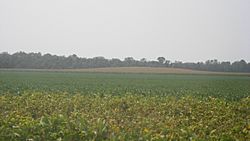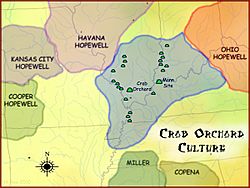Mann site facts for kids

Overview of the site, looking west
|
|
| Location | Mt. Vernon, Indiana, Posey County, Indiana, |
|---|---|
| Region | Posey County, Indiana |
| Coordinates | 37°54′44.5″N 87°50′20″W / 37.912361°N 87.83889°W |
| History | |
| Cultures | Crab Orchard culture |
| Site notes | |
| Architecture | |
| Architectural details | Number of temples: |
|
Mann site
|
|
| Area | 300 acres (120 ha) |
| NRHP reference No. | 74000018 |
| Added to NRHP | October 01, 1974 |
| Responsible body: Private | |
The Mann site is an important ancient place in Indiana, near Mount Vernon. It was home to people of the Crab Orchard culture. This site is so special that it was added to the National Register of Historic Places in 1974.
Archaeologists have found amazing things here, like unique pottery and tools. These items show that the people at the Mann site traded with other groups, including the Ohio Hopewell people. They even traded with groups far away in the southeastern United States, like the Swift Creek culture. The Mann site might have been one of the largest Hopewell sites in the entire Midwest.
Contents
What Was the Mann Site?
The Mann site is a very large ancient complex. It has many mounds, geometric earthworks (shapes made from earth), and places where people used to live. It dates back to the Middle Woodland period, between about 100 and 500 CE. This means it's around 1,500 to 2,000 years old!
The site is located on a high river terrace, which is a flat area of land next to a river. This spot is close to where the Wabash and Ohio rivers meet in southwestern Indiana. The size and complexity of the mounds and earthworks at the Mann site are similar to the big Hopewell sites found in southern Ohio. Some experts even think that more people lived at the Mann site than at any other Hopewell site in the Midwest.
Why Was the Mann Site Important?
Many interesting artifacts have been found at the Mann site. These items are made from materials not found locally, showing that the people traded with others. They also show that the people at the Mann site took part in special Hopewell ceremonies and had a system where some people had higher status than others.
One unique discovery is a large amount of special pottery. This pottery has designs like "complicated stamped," "simple stamped," and "tetrapodal" (meaning it has four feet). While this type of pottery is common in the southeastern United States, it's rare in the Ohio Valley. The designs on some of this pottery are very similar to early Swift Creek culture pottery from Georgia.
Amazing Artifacts and Trade
Scientists have studied these artifacts closely using special tools like microscopes and X-ray analysis. Their studies suggest that many of these unique pots came from the Blue Ridge and southern Appalachian Mountains. Research shows that groups like the Connestee phase people in the Appalachian Summit area traded with Ohio Hopewell groups between 200 and 500 CE.
The pottery found at the Mann site shares similar shapes, decorations, and materials with pottery from these distant groups. This suggests that the fine stamped pottery at the Mann site was made by Connestee phase people in the Appalachian Mountains.
It's rare to find so many of these specific artifacts so far north. This tells us that trade between the Ohio Hopewell people and groups in the Appalachian Summit, Georgia Piedmont, and Gulf Coastal Plain areas happened, but it wasn't super common. Sometimes, pottery would travel north. What's also unusual is that people at the Mann site started making their own pottery with Georgian designs.
For example, a diamond-shaped check pattern found on pottery at the Mann site has also been seen at other Hopewell sites in Ohio, like Seip Earthworks. This pattern also appears at southeastern sites with Hopewell connections, such as the Miner's Creek site and Mandeville site in Georgia, and the Yearwood site in southern Tennessee. This shows a wide network of connections and shared ideas across ancient cultures.
See also



